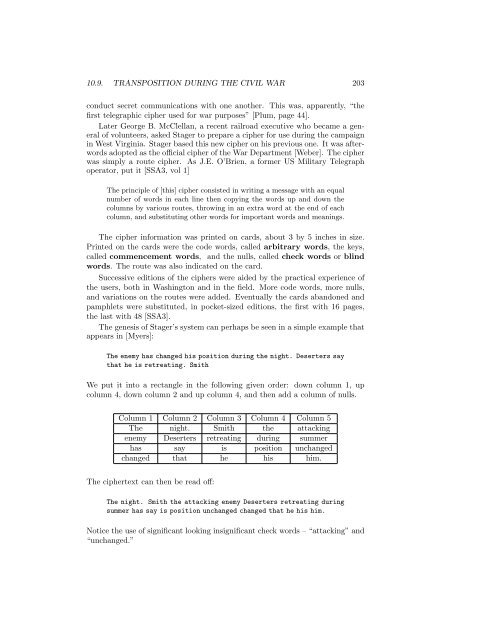Cryptology - Unofficial St. Mary's College of California Web Site
Cryptology - Unofficial St. Mary's College of California Web Site
Cryptology - Unofficial St. Mary's College of California Web Site
You also want an ePaper? Increase the reach of your titles
YUMPU automatically turns print PDFs into web optimized ePapers that Google loves.
10.9. TRANSPOSITION DURING THE CIVIL WAR 203<br />
conduct secret communications with one another. This was, apparently, “the<br />
first telegraphic cipher used for war purposes” [Plum, page 44].<br />
Later George B. McClellan, a recent railroad executive who became a general<br />
<strong>of</strong> volunteers, asked <strong>St</strong>ager to prepare a cipher for use during the campaign<br />
in West Virginia. <strong>St</strong>ager based this new cipher on his previous one. It was afterwords<br />
adopted as the <strong>of</strong>ficial cipher <strong>of</strong> the War Department [<strong>Web</strong>er]. The cipher<br />
was simply a route cipher. As J.E. O’Brien, a former US Military Telegraph<br />
operator, put it [SSA3, vol 1]<br />
The principle <strong>of</strong> [this] cipher consisted in writing a message with an equal<br />
number <strong>of</strong> words in each line then copying the words up and down the<br />
columns by various routes, throwing in an extra word at the end <strong>of</strong> each<br />
column, and substituting other words for important words and meanings.<br />
The cipher information was printed on cards, about 3 by 5 inches in size.<br />
Printed on the cards were the code words, called arbitrary words, the keys,<br />
called commencement words, and the nulls, called check words or blind<br />
words. The route was also indicated on the card.<br />
Successive editions <strong>of</strong> the ciphers were aided by the practical experience <strong>of</strong><br />
the users, both in Washington and in the field. More code words, more nulls,<br />
and variations on the routes were added. Eventually the cards abandoned and<br />
pamphlets were substituted, in pocket-sized editions, the first with 16 pages,<br />
the last with 48 [SSA3].<br />
The genesis <strong>of</strong> <strong>St</strong>ager’s system can perhaps be seen in a simple example that<br />
appears in [Myers]:<br />
The enemy has changed his position during the night. Deserters say<br />
that he is retreating. Smith<br />
We put it into a rectangle in the following given order: down column 1, up<br />
column 4, down column 2 and up column 4, and then add a column <strong>of</strong> nulls.<br />
Column 1 Column 2 Column 3 Column 4 Column 5<br />
The night. Smith the attacking<br />
enemy Deserters retreating during summer<br />
has say is position unchanged<br />
changed that he his him.<br />
The ciphertext can then be read <strong>of</strong>f:<br />
The night. Smith the attacking enemy Deserters retreating during<br />
summer has say is position unchanged changed that he his him.<br />
Notice the use <strong>of</strong> significant looking insignificant check words – “attacking” and<br />
“unchanged.”

















